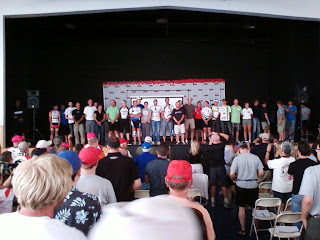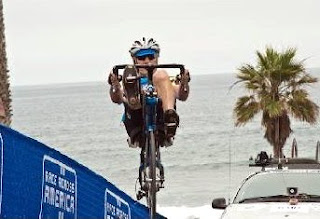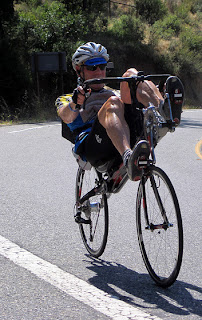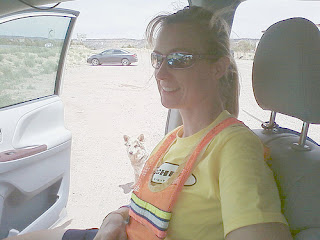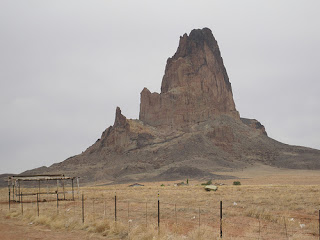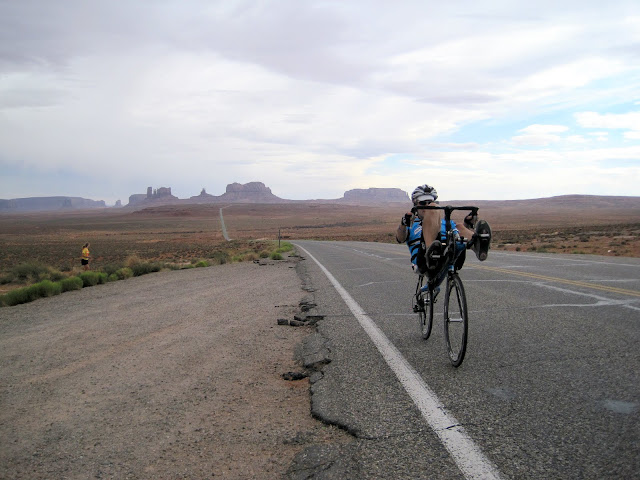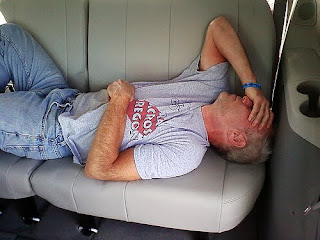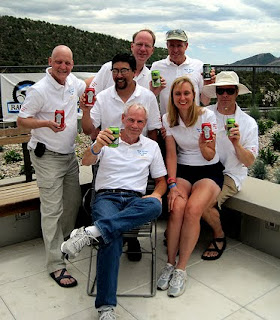Race Across The West
2011
2011
Note: Comments in parentheses reflect information I learned after the race. Time is Pacific Daylight unless indicated otherwise.
A loud siren startled me. Checking my mirror I saw a fire engine just before it roared past. I felt a slight pang of foreboding, but quickly discounted it as mere coincidence. I was about 15 miles past time station number one in Lake Henshaw, and nearing the end of a fairly easy ten-mile climb. The source of my concern was at the end of the climb, the point where the road would tip over the edge of a precipice and drop more than 3,000 to the desert floor below. It’s called “The Glass Elevator,” a marked 8% descent that twists and turns through rock formations for nine miles down the face of the drop-off. The views out over the seemingly endless expanse of Sornoran Desert are spectacular, but there is little chance to enjoy them. The route book carries a special warning unique to the glass elevator: “Caution – dangerous descent.” During The Race Across America in 2006, Jim Kern, concerned that his cork brake pads were quickly wearing away against carbon rims, had resorted to sitting upright on his recumbent to increase wind resistance and slow himself from 55 to a more manageable 50 mph. John Schlitter demonstrated incredible descending skills in RAAM 2008 as we tried to keep up in the follow van at speeds in excess of 60 mph. Regarding this descent he advised me, “don’t let your speed get away from you – brake early and often.” We had driven up the descent on our way into Oceanside from Texas. What worried me most were the swirling winds, gusting 40 to 50 mph, which rocked my van as we made our way up through the corners.
A few miles later my foreboding turned to dread. The fire engine was parked on the side of the road, waiting. A helicopter circled overhead and an ambulance screamed toward me from where the descent began. Please don’t let that be a racer. As I started down I tried to put all of that out of my mind and concentrate on the business at hand. The initial drop was straight and appeared to end in a stair step that would scrub off the speed. The stair step was an illusion; I kept accelerating. Mindful of not letting the rims get too hot I pumped the brakes, reaching about 50 mph before reversing the trend. The road rounded a rock formation and briefly turned back directly into the wind. Even though I was still descending, the headwind was so strong that my speed dropped to 14 mph in a dozen seconds without touching the brakes. I then accelerated just as quickly as the road turned back downwind. The next eight miles the road twisted and turned while the swirling wind gusts hit from every direction. One second they would blow me across the road while entering a turn, the next they would suddenly shift or quit altogether and only a quick adjustment kept me from piling into the rock wall or guardrail. About halfway down I rounded a corner and up ahead emergency vehicles and a race support van were sitting just past the apex of a right-hander. It was what I feared. I was too busy holding my line through the confusion to see what had happened, but the sight reinforced my decision to be cautious. There were no bonus points for excess testosterone on this descent. (After the race I heard that a car had turned across the road in front of a team rider. After a life flight trip to the hospital, the rider was on his way home two days later with a badly broken leg. Given the circumstances, he was lucky.)
The Start
The team had assembled in Oceanside, California on Sunday evening before the Wednesday start. I had been blessed with a dream crew. Last year’s Race Across Oregon crew of David Bradley, Bill Spaeth, and Sharon Stevens was back for more, with David once again in the role of crew chief. They were joined by Jim Kern, Brian Nakagawa, and Phil Plath. All had extensive crewing experience and four of the six had been RAW or RAAM crew chiefs. Brian is one of the world’s best bicycle mechanics. All had tons of racing experience; Jim and Phil had each raced RAAM twice. Most importantly, we were all friends and had the bond of mutual respect and trust that forms the foundation of a great team.
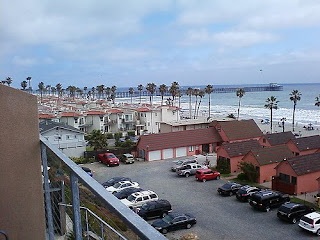 |
| The view from the team pre-race digs in Oceanside. Just a few blocks from the starting line. |
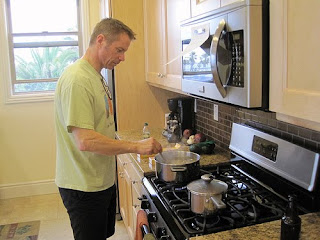 |
| Phil was our chef extraordinare. |
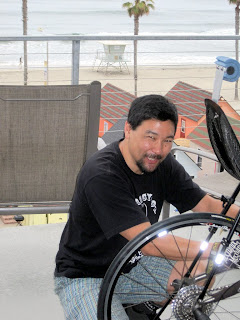 |
| Brian and his bike shop with a view. |
For the uninitiated, Oceanside in the days before the start is a bit overwhelming with hundreds of racers, crew, media, officials and race support staff busily getting everything ready. The tasks that must be accomplished seem endless, but with so much experience our crew knew just what to do. What I had to do was stay out of their way and concentrate on preparing myself. As the start day approached, all of this activity only served to make me more nervous. Scouting and riding the first part of the course was good therapy as well as absolutely essential. In order to get the racers out of Oceanside with as little local disruption as possible, the first 24 miles of the race were ridden unsupported and it was important that I could find my way without getting lost. Riding bonus miles is no way to start an 860-mile race.
The first official event I attended was the racer/crew meeting on Monday afternoon. There were a total of 76 racers and hundreds of crew taking part in solo RAAM, solo RAW, and team RAW. RAAM teams would start later in the week. When crewing for RAAM I always looked forward to this event. It was a thrill to be among so much racing talent, including the world’s best ultra-cyclists. This year, as the racers were introduced, I looked around and felt like a poser. I vowed to myself that by the end of the race I would no longer feel that way.
The Race Across the West was first run in 2008, from Oceanside to Taos, New Mexico, a distance of 1044 miles. Only a single solo racer finished within the maximum allowed time each of the first two years. In 2010 the RAAM route was changed to once again traverse the mountain passes of southern Colorado, eliminating the New Mexico portion of the route. RAW was then changed to end in Durango, Colorado, shortening the race to 860 miles with a maximum allowed time of 92 hours to achieve an official finish. The change increased the number of official solo finishers in 2010 to seven.
 |
| Race director George Thomas being interviewed by ABC sports. |
In the 50 – 59 age category there were two men who had previous RAAM experience, Americans David Opel and Mike Dunlap. David, 54, had finished RAAM in 2010 as part of a two-man team. Mike, also 54, had DNF’d (“did not finish”) shortly before Durango while racing solo RAAM in 2010. His cycling experience included a double crossing of South Dakota, finishing 828 miles in 65 hours. Also in the 50 – 59 age group was American Chris Malloy, 58, the only other recumbent rider in the race. Chris had DNF’d during the first RAW in 2008.
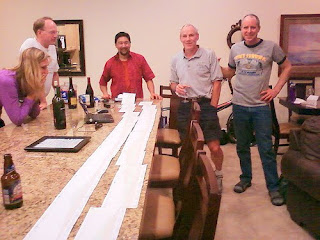 |
| Reviewing the race profile. |
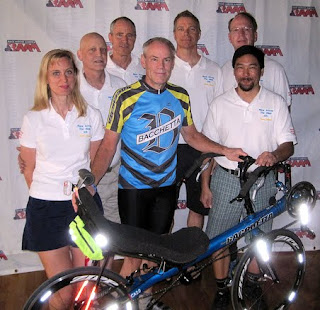 |
| The best crew ever! |
 |
| David handles one last interview. |
I rolled down the ramp, through the crowd, and along the start chute. As I passed the staging area the follow van pulled out behind me. I turned and followed the chute up the short steep hill away from the beach. Thank God police controlled the intersection at the top so I wouldn’t have to attempt a "RAAM-stop" on this steep grade. Several blocks later I was directed onto the bike path that allowed us to avoid busy city streets for the next seven miles. The follow van took another route to mile 24 where they would wait for me. As the bike path ended and we were directed onto surface streets, I caught the rider ahead of me. A block later I passed him on a gentle climb. Suddenly, finally, all the drama and frenetic activity of the last few days was behind me and I was racing!
The First Night
 |
| Daytime support was via hand-offs throughtout the race. |
At the end of the Glass Elevator is the small town of Borrego Springs and the traffic roundabout known as “Christmas Circle.” All race support vehicles and crew except for one follow van per solo team take an alternate route to this rendezvous point, as I had done during the three years I had crewed for RAAM. I remembered well the hours I had spent here waiting to get a glimpse of our rider. Those memories made for a very special moment when the crew cheered for me as I flew through the circle and turned south. We were 85 miles into the race and I was starting to pass a few riders. I felt good, but I was worried I was going out too fast. (I had passed through the first time station at 4:39 pm in 15th place, but I had several riders just ahead. Only 4 minutes separated me and 11th place.) My average heart rate was too high, although much of that was no doubt due to the heat. From Oceanside to the top of the Glass Elevator is mostly climbing, including a seven-mile, seven-percent grinder just before Lake Henshaw. I shouldn’t be catching other riders yet. I remembered that John Schlitter felt that he had gone out too fast in solo RAAM and paid for it the next day. As I now headed south out of Borrego Springs we would be on the desert floor for the rest of the night. Local time was 6:30 and things were starting to cool off. I needed to dial it back a little.
 |
| Rolling through Christmas Circle. |
We arrived at TS #2 in Brawley at 8:47 pm. (For the 89 miles since TS #1 we had averaged 21.4 mph overall, 21.9 on-the-bike, and moved from 15th place up to 7th.) Under nighttime rules Bill and David were following directly behind me as we left Brawley, lighting my way, protecting me from traffic, handing off some solid food and hot soup, and generally providing some much welcomed company. It had cooled off and I was soon riding through a rolling sea of sand dunes shimmering in the light of a full moon. What a great night for a bike ride! The 90 miles to TS #3 in Blythe travels northeast over a long gentle hump, starting a hundred feet below sea level and gradually climbing to 1,100 feet over 35 miles before descending back to a couple hundred feet above sea level. I knew I still needed to ease off a bit, but I was making great time. I thought I would hold off until the backside of the hump where the gradual descent would allow me to dial it back some while keeping my speed up. However, when I got over the top there wasn’t a smooth gradual downgrade, but rather more than 15 miles of short, sharp descending rollers. Such terrain is custom made for really flying on a recumbent as long as you power over the top and down the rollers so that you keep your momentum high and avoid bogging down on the upgrades. Dialing back the effort would have to wait.
Finally the road leveled off for the last 25 miles and we arrived at TS #3 in Blythe, at 1:27 am. (Since TS #2 we had averaged 19.2 mph overall, 19.7 on-the-bike, and moved from 7th place up to 4th.) After a quick stop we headed north out of Blythe. The route crossed over to the Arizona side of the Colorado River before arriving at TS #4 in Parker, 51 miles later. The terrain was desolate with lots of mostly small gentle hills. I was finally able to ease off a little but we continued to make good time. We arrived in Parker at 4:19 am. (Dani Wyss was in the lead, Peter Oyler was in second and David Opel was in third, one hour and 17 minutes ahead of me. Sometime between Brawley and Blythe I had passed Mick Walsh, Gregory Robinson, and Mike Dunlap. I don’t remember actually passing anyone, so it must have been while they were stopped. I wasn’t thinking about it much, but I assumed I was at best in the middle of the field.) Our first night of racing had been better than I could have hoped for, but the critical second day was about to begin. The coming climbs from Congress to Prescott in the afternoon heat would tell the tale of the race.
The Second Day
From Parker the route turns back southeast for a gradual 56 mile upgrade to Salome. The change in direction meant that we were now riding directly into the wind. At 6 am we had to switch back to daytime rules, which meant no more direct follow support. The follow van had to leap frog and do roadside hand-offs only. Normally during a long race the sunrise picks up my spirits, but the scenery
was featureless, the road didn’t have a shoulder, the truck traffic was increasing, and I was grinding into a headwind while squinting into the sun. Not a great way to start the day! Finally we turned northeast just before Salome, reaching TS #5 at 8:34 am. We exchanged the disc wheel for the lighter Zipp 404 and I thanked the Renn disc for the great job it had done. While we had traded the headwind for a cross to quartering tailwind, we also exchanged a slight upgrade for a continuous, gradually increasing climb. The chip seal road surface was becoming rougher and the heat was quickly becoming oppressive. Most of the highway was perfectly straight and the scenery all looked the same, i.e. hot, dry, boring, and hot. Ugh! I didn’t remember it being so far to Congress. Sharon and Jim did a great job keeping me as cool as possible. I was riding with a bag of ice on my chest and during one quick stop they massaged my legs
with ice. At last we made it arriving 7 minutes after noon. Bill told me that so far we had ridden 395 miles in 23 hours 44 minutes, including 48 minutes of stopped time. (I was holding 4th place and given how long it seemed to take to ride this section, I was shocked to find out that I covered it in the fastest time. Dani Wyss had one of the slowest times and must have stopped for a couple of hours.)
 |
| The beginning of Yarnell Grade. |
Now came the hard part. In the 46 miles between Congress and TS #7 in Prescott were two sections that totaled about 6,000 of climbing. The first was Yarnell Grade, just over seven miles long at about 7%. It’s not all that tough, but I’d picked a very hot time of day to climb it. About halfway up I saw a van come by with two trikes on the back. It was Chris Malloy’s van. I was sad to see both trikes because that meant that he must have DNF’d. (Sometime during the night the flashing amber lights required for the top of Chris’s follow van had shorted out and caused him to abandon the race. Another advantage of having such an experience crew was that I did not have to worry about such things; our back-ups had back-ups.)
We stopped briefly at a gas station a few miles past the top of the climb. While the climb hadn’t been easy, I was feeling good. A couple of folks who had seen me on the climb pulled alongside and were asking about the bikes. I started to explain some of the advantages of riding a recumbent when I had to excuse myself and hurry to the other side of the van to throw up. Uh-oh. I’d been to this movie and I had no desire to see it again. The previous year at RAO I had a near disastrous experience during a very long climb in extreme heat. This was a bad sign. Having vomited I would immediately be low on calories and hydration. We had a gradual descent for the next 12 miles and I tried to get my calories and hydration back up, but by the time the road started to climb again I was in trouble. I couldn’t maintain power or cadence and my heart rate was running way too high. I momentarily panicked. If I had trouble climbing in the heat on the way to Prescott our back-up plan was to stop for an hour and a half sleep break and then ride through the night. Once I had a chance to calm down and think about it, I decided it was just too early for a major sleep break. When the follow van leaped frogged around the next time, I suggested that we just try a 20-minute power nap and see if that helped. Before lying down I quickly consumed some calories, water, and ibruprofen. I was having a little trouble falling asleep, but a couple of seconds later Brian was waking me and saying I had been asleep for 20 minutes. Phil gave me a Five Hour Energy and directed my butt back to the bike. The nap worked and soon my power and cadence were back up, my heart rate was holding and I was feeling good. In fact, I was having fun and riding hard. Amazing!
The next 20 miles consisted of nearly continuous switchbacks with alternating steep climbs and technical descents. The scenery was beautiful. As I completed the final descent and neared the outskirts of Prescott I remember enjoying the fragrance of the pine forest. However, fun done, there was work ahead. It was after 5 pm and we would be riding 12 miles through the heart of Prescott in rush hour traffic. This is the sort of thing that instills a significant pucker factor in a crew, but when they pull it off, it’s a major adrenaline rush. Under the new rules, in addition to all the normal difficulties, the crew would have to get me through using leap frog support only. This was going to be interesting! The streets were two and three lanes in each direction and were jammed with traffic. Brian and Phil in the follow van would try to stay as close to me as possible so they could give me directions over the radio, but had to avoid following me directly or interfering in any way with the flow of traffic. Meanwhile, David had pre-positioned the other crew members to make sure I didn’t miss key turns. We got through with no problems. Not only had they pulled it off, it had been a thing of beauty! (As we went through TS #7 the order remained the same, but David Opel in third was now 3 hours 22 minutes ahead of me. Mike Dunlap in 5th was 3 hours 41 minutes back.)
The Second Night
Once on the other side of the city we headed northeast toward Cottonwood, 41 miles away. The route would take us on a 12-mile climb over Mingus Mountain and then down a very long technical descent into Cottonwood. The climb wasn’t too bad, but it was dusk as we started the descent and I struggled to pick out my line on rough and patched roads through a myriad of 20 mph hairpins. Halfway down the road enters the narrow twisting streets of Jerome, a scenic little town which hangs on the side of the mountain. Luckily it turned 8 pm shortly before I arrived in Jerome and Brian brought the follow van up into direct follow position behind me. I was still moving pretty fast when, just in time, the van’s headlights lit up the missing street ahead of me. A block-long section of the right lane had been removed and a six-inch drop to the rocky road bed was all that was left. With nowhere to go I moved to the opposite side of the road before realizing that I was now on a head-on collision course with a car a half-block away. Oops! The follow van had slowed down and taken the direct route. With no place to go, I slowed as quickly as I could and moved as far to the right of the lane as possible without riding off the edge. The approaching car moved to my left and as close as it could to a retaining wall. We passed a few inches apart. Once out of Jerome we resumed descending on better roads into Cottonwood, arriving at 8:34 pm.
 |
| Bill beginning his sleep shift in our rolling motel. |
All too soon I was back on the bike and headed north. I pushed pretty hard on the climb while David kept me apprised of the time. We wanted to get through Flagstaff as early as possible to avoid traffic, but also, if we made it before 6 am, we could ride through the city using direct follow support. Flagstaff lies at 7,000 feet and it became progressively colder as we neared the city. We entered the outskirts a little after 5 am and were making good time through empty streets until we came upon an Amtrak train blocking the road. While we waited Bill held the bike and I got warmed up in the van. After eight minutes we were back on our way, arriving at TS #9 at 5:34. (During the night there had been the inevitable shake-up in the order as riders stopped for sleep breaks. I had gone through Cottonwood in 3rd place, but by Flagstaff I was once again in 4th. David Opel was again in 3rd, 5 hours 4 minutes ahead of me. Gregory Robinson had taken over 5th place and was 2 hours 23 minutes back.)
The Third Day
We had only stopped for a total of 13 minutes since leaving Flagstaff eight hours earlier. It was time for a bio break and time to find out where I stood among the field. While I took care of the former I asked the crew to pull together the stats on the latter. Since I had no idea where I stood I was shocked and pleased to find out I was in fourth. This put the remainder of the race in a new context. Trying to catch Opel would probably be futile unless he faltered in a big way. Also, given that I had now raced further and longer than ever before with just over three hours of sleep, and that I still had 180 miles to go with a lot of climbing almost all of it at altitudes higher than I had ever ridden, a big push to try to reduce the gap to 3rd might jeopardize finishing. Since Flagstaff I had been holding my own against Opel while pulling away from Robinson. I decided to keep doing what I had been doing while trying to step it up a bit. This did mean, however, that a second sleep stop was out of the question. As I headed out David said something about paybacks being hell. Huh? I took the turn north and started riding toward Monument Valley. Suddenly I realized what he meant. I was riding into a nasty headwind. I started to mutter something to myself and then stopped mid-complaint. After the tailwinds I had for much of the race, if I complained now I would be asking to be struck by lightning. I shut up and rode. It was getting cloudy and I guessed that this was a small front moving through. It could be a problem if the winds shifted back before those following me arrived, but changing conditions are just part of point-to-point racing. There was nothing to do about it but just keeping moving.
Riding among the iconic rock formations of Monument Valley was in itself a dream come true. Memories of having come through the valley while crewing on previous RAAMs came flooding back. I couldn’t quite believe that it was me doing the riding this time. After climbing out of the valley we descended to TS #12 in Mexican Hat, UT, arriving at 5:06. The next 40 miles were tough with lots of short steep climbs, but the scenery was breathtaking. From a follow van I had never before noticed the views down into the Valley of the Gods, but in the warm light of approaching sunset it was so beautiful it was everything I could do to avoid stopping to stare. It was 8:05 when we arrived at TS #13 in Montezuma Creek, UT. The headwinds had cost us a lot of time.
The Third Night
The 50 miles to Cortez, CO held bad memories. It was during this section in 2006 that we had pulled Jim Kern from the course and rushed him to the hospital. He had begun coughing up blood. We turned off the highway and onto a ranch road. At first I thought we had made a mistake; there was gravel everywhere. It turned out we were on the right road, if you could call it that. Somebody had decided to resurface the road with chip seal, although they had only completed the chip part. We were climbing in loose gravel that was often several inches deep. Bill did a great job of steering the van as close as possible to help me see. I was all over the road fighting to stay upright while trying to avoid running into the van. I kept asking David and Bill how long this went on. The answer soon became apparent – forever. Oh my God! I’m averaging six mph in this stuff. If it’s like this all the way to Cortez it could take eight hours! The needle on my grumpy meter was nearing the red zone. Finally, after struggling for an hour, the gravel ended and the road surface returned to its previous lousy condition. Thank God! The rest of the section continued the constant climbing, reaching over 6,000 feet in Cortez. It’s often the kind of gradual grade that has no visual clues that you are climbing, particularly at night. It just feels like you are working really hard and going really slow. The sleep monster was starting to stir and I was taking caffeine to keep going. By the time we reached Cortez at 1:46 am local time, I felt frustrated and worn out.
The final 46 miles of the race climbs to over 8,400 feet before descending into Durango. I was concerned about the final section. It would be cold and the air thin. Also, after my experience at RAO I was hesitant to risk falling asleep while descending. Thinking about the dramatic benefits of my power nap before Prescott and after checking with the crew to make sure I could afford the time without risk of being overtaken, I decided to take a 30 minute nap. The sleep helped, but the stop had been costly lasting a total of 50 minutes. After climbing for 30 miles we reached the summit at dawn. A quick stop for a dry jersey and a few sips of hot soup and we started down. I was wide awake but shivering in the cold. When we reached the bottom all that was left was the final 2.5 mile climb to Fort Lewis College. I rode down the chute and across the finish line at 7:19 am local time. It was a beautiful morning in Durango.
The Results
Our final time was 65 hours 56 minutes. With 8 hours 51 minutes of stopped time, our average riding speed was 15.1 mph. During the race I had slept for a total of 3 hours 50 minutes. Dani Wyss, demonstrating why he is one of the best ultra-cyclists in the world, won the race in the incredible time of 48 hours 29 minutes. Peter Oyler finished second and David Opel third. I finished fourth overall and second in the 50 to 59 age category. At 58, I was the oldest racer to finish and fastest among riders lacking previous RAAM experience. And I was the first recumbent ever to finish RAW.
www.Bacchettabikes.com
www.moylantraining.com
www.sarcomahelp.org
